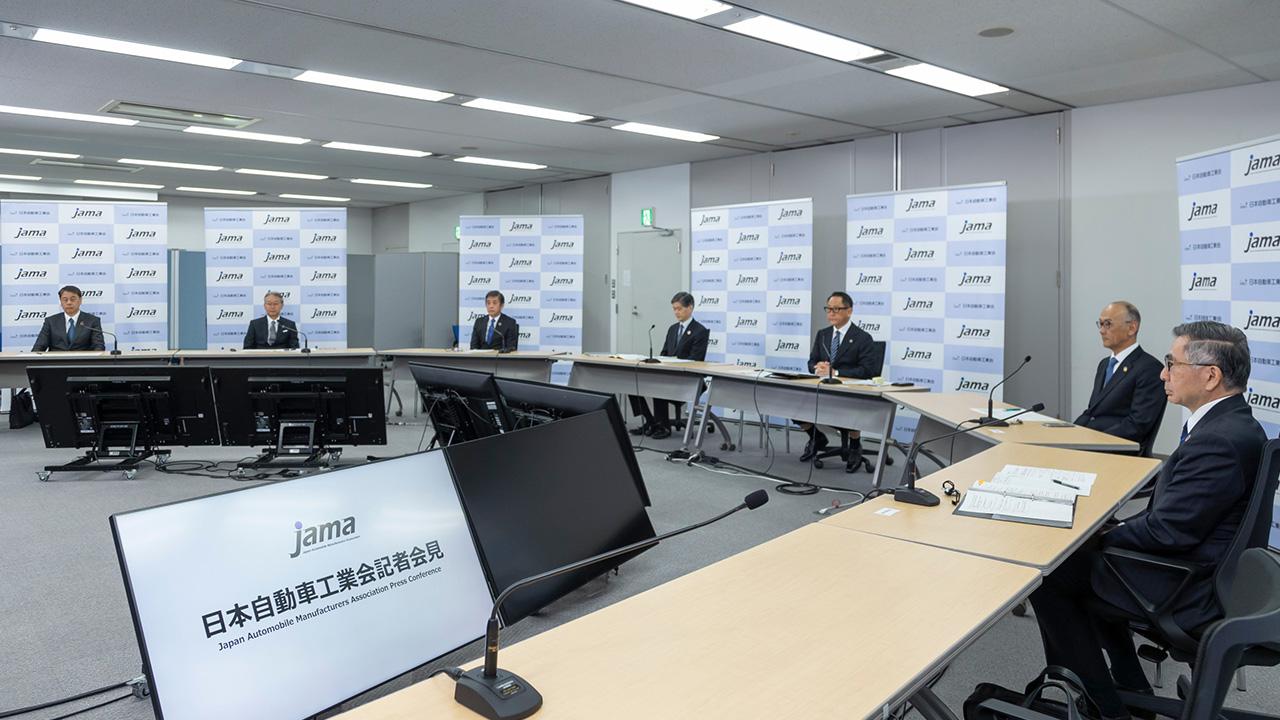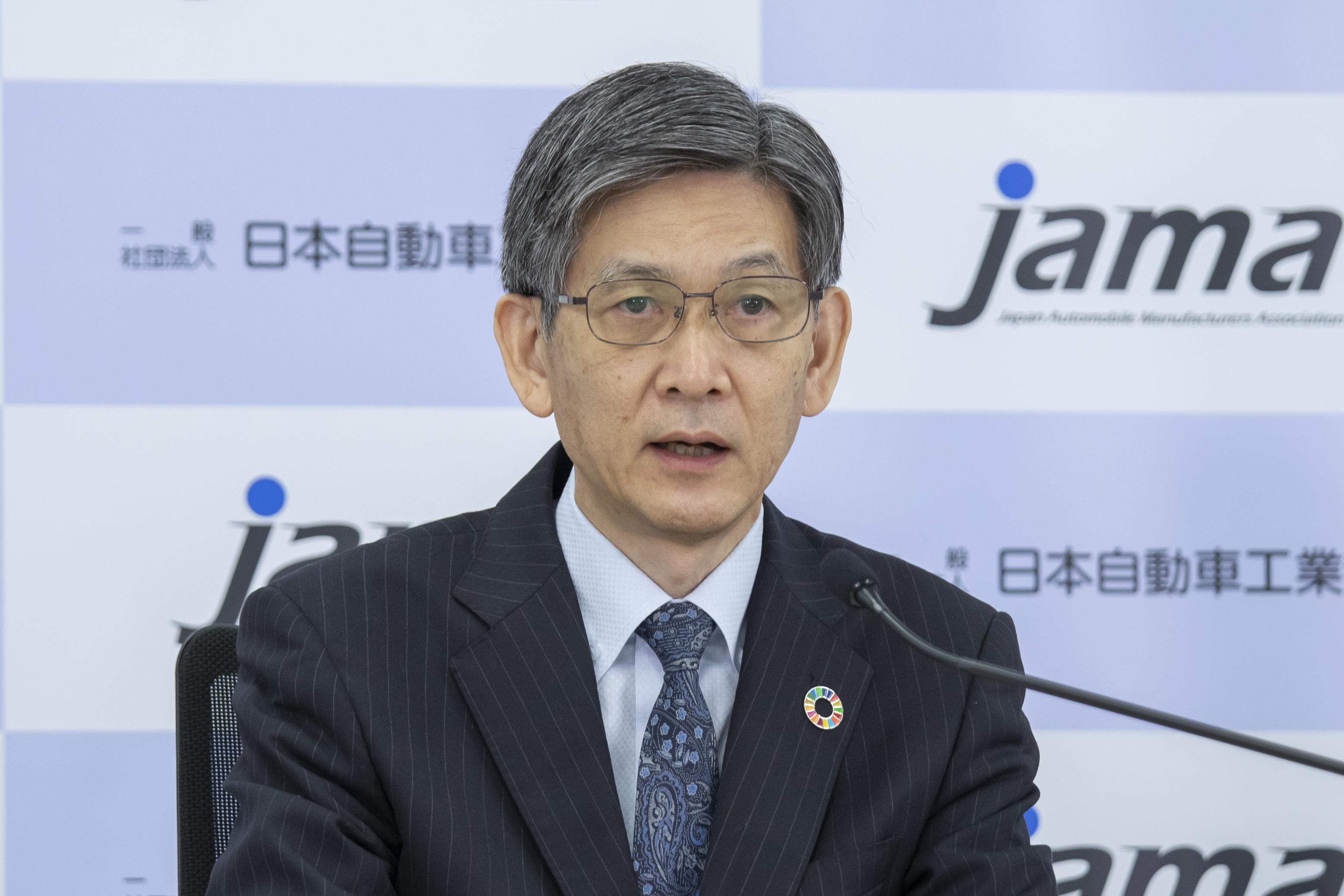
With its diverse range of technologies, Japan's auto industry seeks decarbonization through collaboration, not rivalry.

On May 18, 2023, the Japan Automobile Manufacturers Association (JAMA) held an online press conference.
Coming on the eve of the G7 Hiroshima Summit, the briefing sought to inform world leaders about Japan’s unique path to carbon neutrality.
At the press conference, all seven JAMA vice chairmen were present alongside Chairman Akio Toyoda. They were also joined by Executive Director Akira Marumoto of Mazda, whose headquarters are located in Hiroshima.
Chairman Toyoda spoke first.
Peace for all people
Chairman Toyoda

Tomorrow, the G7 Summit will get underway in Hiroshima.
As the situation in Ukraine brings uncertainty and growing fears of nuclear escalation, I see it as highly significant that the G7 nations have gathered in Hiroshima, the site of an atomic bombing, to discuss global peace and sustainable development.
Japan is the only country to have experienced an atomic bomb. As the nation’s auto industry, our core desire is to help ensure peaceful lives for all of the earth’s people.
Just four months after that tragic day 78 years ago, Mazda restarted production of its three-wheelers, greatly contributing to the revival of its native Hiroshima.
Desperate to recover from the ravages of war, everyone worked together, with Subaru producing bicycles and agricultural machinery as Toyota made cooking pots.
Seventy-eight years on, cars have become an even more integral part of our society and planet.
We want to sustain the lives of people all around the world, ensuring that no one is left behind, and safeguarding a bountiful earth. This vision is linked to our pursuit of carbon neutrality.
Japan’s auto industry serves a global market with a full lineup of products, from passenger cars to minivehicles, heavy-duty, and motorcycles.
No other country is home to such a diverse array of automotive companies. And with battery electric vehicles (BEV), hydrogen, and hybrids (HEV), I believe that technological diversity is one of the key strengths built up by Japan’s auto industry.
Underpinning all these technologies is the desire to put smiles on the faces of our customers.
Different countries and regions have different cultures and different lifestyles. If the roads are different, the way that cars are used will differ.
Despite everyone living in different circumstances, they are all our customers. We want to embrace the reality of each country and region, respect these differences, and live hand in hand with diversity.
Achieving this requires a diverse range of technologies. Japan’s companies must hone the technologies at which they each excel to become more competitive, and then harness these technologies in the regions where they are needed. We believe in this “multi-pathway” approach for the Japanese auto industry.
During the G7 Summit, we will showcase these efforts here in Hiroshima. With the cooperation of partners from various industries, we will exhibit a diverse range of mobility in the hope of demonstrating a uniquely Japanese path to carbon neutrality.
Tomorrow, JAMA’s vice chairmen will be in Hiroshima to present the Japanese auto industry’s vision for various technologies to the rest of the world.
Finally, I would like to share part of a message that two sixth-grade students, speaking on behalf of children everywhere, delivered at the Peace Memorial Ceremony held in Hiroshima on August 6 last year.
I believe the same holds true for carbon neutrality.
We must recognize our differences, and understand each other—then work together to eliminate our common enemy, carbon, as soon as possible by doing what we can do now.
In doing so, I believe we can achieve definite results while ensuring that no one is left behind.
I ask for your unwavering support as we continue to work for our future, and for our planet.
What’s on display in Hiroshima
From there, the conference moved on to a Q&A session. Vice Chairman Seiichi Nagatsuka responded to comments about the shift to BEVs outside Japan, including regulations.
Vice Chairman Nagatsuka

Although the positions of individual countries differ, what I see as the common thread is that all are engaged in discussions toward the ultimate goal of reducing CO2 emissions.
We need to work together, starting with what we can do right now. In this way, we feel that we can achieve definite results, reducing CO2 emissions and preventing global warming, without leaving anyone behind.
“Starting with what we can do right now.” Executive Director Marumoto of Hiroshima-based Mazda elaborated on Japanese auto industry efforts by introducing the exhibits at the G7 venue.
Executive Director Marumoto (Mazda)

Our display at the G7 venue will be divided into seven zones, showcasing the technologies and products that each company’s engineers have poured their souls into developing.
When I visited yesterday to check the preparations, seeing all those different technologies and products was a reminder that diverse options are not only important but also, as the chairman has said, the strength of Japan’s auto industry.
Witnessing the passionate vision of each company’s engineers, I also gained a sense of our future possibilities.
Vice Chairman Makoto Uchida of Nissan also provided additional comments on the intentions behind each company's exhibition.
Vice Chairman Uchida(Nissan)

We are showcasing various technologies from different companies to demonstrate our commitment to decarbonization.
We encourage visitors to come to the venue and learn about the initiatives each company is undertaking.
As socially responsible companies, our exhibitions show our genuine desire to address climate change in a meaningful way.
All of us here are approaching this exhibition with the same mindset.

